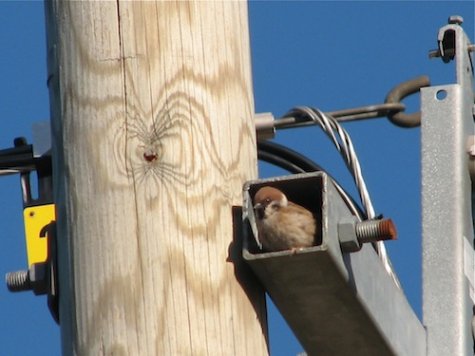Sparrows – on duty power line guardians
Test and photos Eet Tuule and Aarne Tuule, www.tallinna-linnuklubi.ee
Translation Liis
Tree sparrow on home threshold.
Tree sparrow Põldvarblane Passer montanus
The period of heaviest responsibilities in the life of birds is of course the breeding period. Over many generations all species have developed their own typical locations in the choice of nesting places where the upbringing of offspring should succeed. But there will always be inept as well as smart nesters. As well as the ones who go for highly innovative solutions.
In the Saue and Saku municipalities in Harju county for instance white storks, buzzards, kestrels, collared turtle-doves, ravens and hooded crows have nested on the high-voltage transmission towers over the years. The concrete poles of railway lines were taken over by jackdaws and starlings at once after the start of electric train traffic. It seems that lately tree sparrows have made increasing use of the power transmission lines. It is a fact that the number of small transformers, for transforming high-voltage power to 400 V low voltage at villages and solitary farms, has gradually increased in the countryside. In a couple of places tree sparrows quickly discovered that the transformer stands made of hollow steel profiles were wonderfully suited for their nests.
The number of house sparrows decreases slowly but steadily in the country, but instead tree sparrows increase. The problem is only that suitable nest spots become ever fewer because there are no longer such nesting opportunities at modern houses as there were in the old farmhouses. Thus it is no wonder that innovative discoveries by one or some clever sparrow pairs are increasingly imitated by their conspecifics. At least in the area observed by us this use of new nesting spots is clearly visible. Several more on duty electricians–sparrows hop and skip on the thresholds of their steel profile box houses this year than the previous one …
But nests are built elsewhere too. Thus two or three tree sparrow pairs have installed themselves in their annual spots among the outer branches in a white stork nest.









